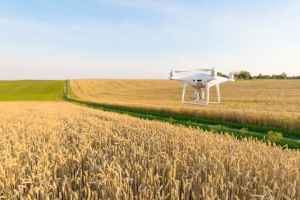Technological innovation in agriculture is matched by innovative insurance
It is estimated that 20% of all UK farming businesses are implementing technological innovation using Unmanned Aerial Vehicles (UAVs).
UAVs are now becoming a critical component in modern agriculture with farming businesses utilising them for tasks such as seeding, crop spraying and herd monitoring. This adoption of UAV technology is not just a trend; it’s a revolution for the industry, offering solutions to some of the most pressing challenges faced by farmers today.
Equipped with cameras and sensors with options for infrared, these aerial devices are providing farmers with a bird’s-eye view of their fields and crops, allowing them to make informed decisions much more quickly, optimising their resources and greatly enhancing overall efficiency.
It began as a way of doing easy and effective crop reviews, but UAV technology has rapidly developed so that these eyes in the sky are now able to take on a wide variety of formerly labour-intensive tasks including spraying, pest control and precision agriculture in large fields. This increased functionality and adaptability, together with a fall in the cost of UAVs has generated their rapid adoption as a valuable tool in British farming.
UAVs can be equipped with advanced sensors that capture data in real-time on crop health, letting the farmer know when it identifies areas affected by pest diseases or deficiencies in nutrients. This use of technology avoids the unnecessary application of chemicals across entire fields. This not only reduces costs but also minimises the environmental impact, a growing concern in today’s world. Moreover, UAVs can reach areas that might be difficult or dangerous for humans or machinery, such as steep slopes or waterlogged ground, ensuring no part of the land is left untended.
UAV sensors can also accurately pinpoint areas where crops are short of water just by analysing the type of light being reflected by the leaves. It is a level of sophistication unheard of in British agriculture, just a few years ago.
Managing New Risks and Opportunities
 As UAVs become an integral part of farming operations, they introduce new risks and considerations that must be managed. At Camerasure Towergate, we see this technological shift as both an opportunity and a challenge. On one hand, the precision and efficiency of UAVs can lead to better crop yields and lower operating costs, which is good news for both farmers and insurers. On the other hand, the use of drones introduces new liabilities that must be carefully considered.
As UAVs become an integral part of farming operations, they introduce new risks and considerations that must be managed. At Camerasure Towergate, we see this technological shift as both an opportunity and a challenge. On one hand, the precision and efficiency of UAVs can lead to better crop yields and lower operating costs, which is good news for both farmers and insurers. On the other hand, the use of drones introduces new liabilities that must be carefully considered.
For instance, what happens if a drone malfunctions and causes damage to crops, property, or even injures someone? These are scenarios that were virtually unknown a decade ago but are now very real possibilities. As such, it’s crucial that farmers using UAVs have the right insurance coverage in place. This includes not only coverage for the UAVs themselves but also liability coverage to protect against potential accidents.
The data collected by UAVs can be an asset in the insurance process. High-resolution images and detailed crop health data can provide insurers with a clearer picture of a farm’s risk profile, leading to more accurate and fairer premiums. In the event of a claim, this data can also be used to assess the extent of the damage more accurately and speed up the claims process, benefiting both the insurer and the insured.
Investing in such high-tech equipment for farming requires insurance that is flexible and provided by insurance companies that fully understand farming, how UAVs and the data they provide can be used and the potential problems that farmers can run into when things go wrong.
The company provides cover through a specific aviation insurer syndicate, Tokio Marine Kiln, which is very familiar with the complex nature of aviation risks, which leaves us well positioned in the event of a claim, particularly on liability issues. Also, the simplicity of being able to insure a huge variety of business activities provided the client observes CAA regulations, as well as specific extensions for the agricultural industry, such as chemical liability for crop spraying, means we are flexible in providing solutions for farmers who want to use this technology.
We have dealt with many claims where we have been able to aid our clients. These are wide-ranging from a large drone crashing into a harbour where our insurers were able to assist the owner in finding a repair solution, to settling many claims in diverse situations from theft of UAVs from vehicles to drones being attacked by flocks of seagulls!
Over the course of the year, 50% of the claims received have related to accidental damage to the drone, 35% to loss of the UAV and 15% to theft where drones stolen from vehicles are a major target for thieves. All claims from Camerasure customers are handled by dedicated, experienced aviation loss adjusters and data from UAVs in support of claims is valuable for a swift solution.
Why This Is a Pivotal Moment for UK Farming
The adoption of UAV technology represents a fundamental shift in how agriculture is conducted. The ability to gather real-time data, make informed decisions on the fly, and implement precision farming techniques is transforming the industry into a high-tech, data-driven enterprise. For farmers, this means healthier crops, reduced costs, and a more sustainable approach to farming. For the insurance industry, it means adapting to new technologies and finding ways to manage the associated risks effectively.
We believe that supporting farmers through this transition is critical. As UAV technology continues to evolve, so too will the insurance products designed to protect these vital assets. We are committed to staying at the forefront of these developments, ensuring that our clients have access to the most up-to-date and comprehensive coverage available.
The Future of Farming and Insurance
 The DJI Agriculture Annual Report confirmed that the global agricultural UAV industry is booming. By the end of June 2024, agricultural UAVs had already treated more than 500 million hectares of farmland around the world. This has resulted in a cumulative reduction in the use of water of 210 million metric tonnes and most importantly a reduction of some 47,000 metric tonnes of pesticides
The DJI Agriculture Annual Report confirmed that the global agricultural UAV industry is booming. By the end of June 2024, agricultural UAVs had already treated more than 500 million hectares of farmland around the world. This has resulted in a cumulative reduction in the use of water of 210 million metric tonnes and most importantly a reduction of some 47,000 metric tonnes of pesticides
Implementation of agricultural UAVs has also significantly decreased carbon emissions in farming. Estimates put the reduction at 25.72 million metric tonnes. This reduction is equivalent to the carbon sequestration provided by 1.2 billion trees, which underscores the sustainable and eco-friendly nature of this innovative approach to modern agriculture.
Looking ahead, the integration of UAVs into UK farming is set to expand even further. As more farmers recognise the benefits of this technology, the percentage of farming businesses using drones is likely to increase. This will lead to greater efficiencies, more sustainable practices, and potentially higher profits for those who embrace the change.
From an insurance perspective, this technological revolution underscores the importance of innovation and adaptability. The risks associated with UAVs are new, but they are manageable with the right approach.
- Log in to post comments

